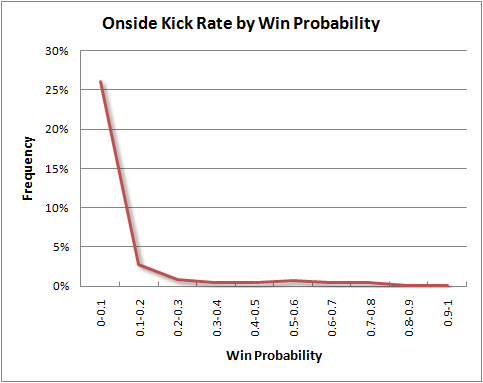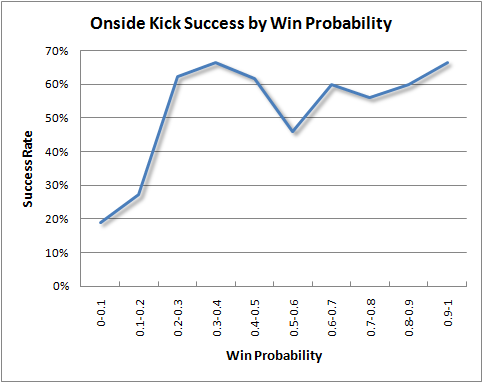Onside kicks in the NFL are successful 26% of the time. It’s true, but it’s also very misleading. Onside kick success rates are very dependent on whether the receiving team is expecting one.
As you can see in the chart below, a plot of the frequency of onside kicks by win probability (WP), teams don’t usually attempt onside kicks unless they’re pretty desperate. Teams typically attempt them when they have less than a 10% chance of winning. Even then, they only do it about 26% of the time.

The effect of surprise on the success of an onside kick is pretty big. The chart below plots success rate by WP. The less a team is expecting an onside kick, the more successful it is. When teams are expecting it, when WP is about 0.15 and below, the success rate is about 20%. But when teams aren’t expecting it, the success rate averages 60%. (There are 103 onside kicks classified as 'surprise' in the data, which results in a standard error of +/- 4.8%.)

What does this mean for surprise onside kicks? Are they worth the risk given a 60% success rate? We can answer that question with an analysis based on
Expected Points, the average of next points scored for first downs at each yard line on the field. In the following example, I’ll solve for what the break-even success rate would be for an unexpected onside kick.
The EP for a failed onside attempt is -2.1 pts, and the EP for a success is +1.2 pts. At first glance it appears onside kicks are always losing propositions. But don’t forget that you’ve always got to kickoff somehow, and a normal kickoff averages -0.7 pts for the kicking team.
EP(normal KO) = -0.7
EP(onside recovery) = +1.2
EP(onside failure) = -2.1
Let’s call the success rate ‘x’. Solving for the break-even success rate, where the combined expected points of an onside kick equal that of a normal kick, we get:
1.2x + (1-x)(-2.1) = -0.7
1.2x - 2.1 +2.1x = -0.7
3.3x = 1.4
x = 42.4%
So 60% is a lot more than the break even success rate of 42%, and as long as a team has the element of surprise, onside kicks are well worth the risk—at least under ‘normal’ football conditions. Late in games, however, depending on the score and time remaining, we can’t use the EP analysis anymore. We need to turn to win probability analysis, something I’ll look at
in part 2 of this article.
The catch is that teams can’t do this very often. The key is that the onside attempt is unexpected. As soon as a team is known for sneaky onside kicks, its success rate will go down. But this isn’t such a bad thing. As opponents are forced to respect the threat of an onside kick, their normal kick return blocking will suffer, allowing overall net kickoff distance to improve. Ultimately, there would be an equilibrium, making life more difficult for the receiving team.




